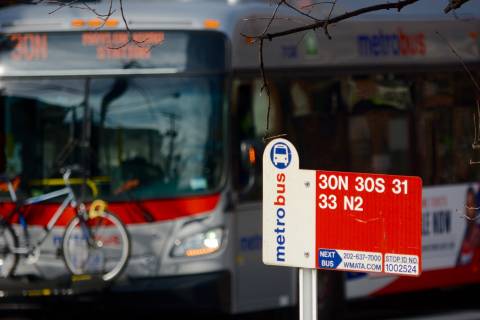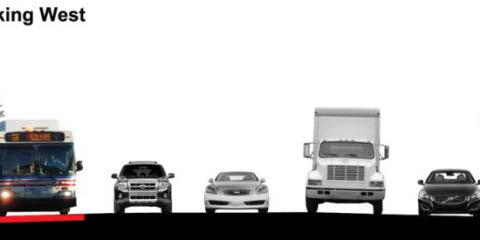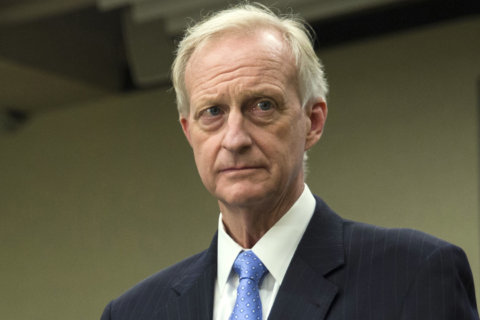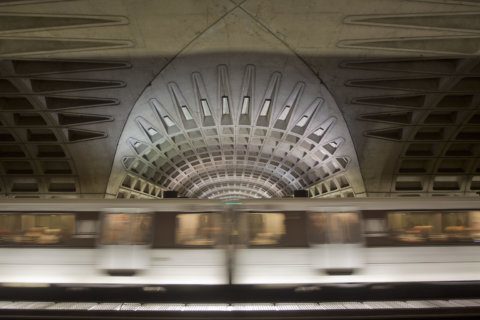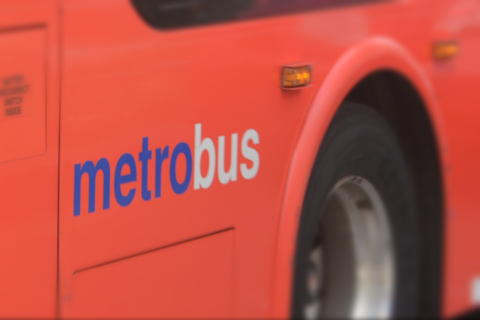Taking the bus is too frustrating in D.C., and major changes are needed if the city is going to deal with significant problems facing commuters, a new Metrobus report card finds.
Buses are stuck in so much traffic and can be so inconsistent that the number of ride-hailing trips in D.C. through companies such as Uber and Lyft could surpass the number of trips taken on buses this year for the first time.
The report released Wednesday by the Coalition for Smarter Growth and MetroHero reviewed 34 routes on D.C.’s busiest bus corridors.
“The results of this analysis paint a striking picture of the problems Metrobus encounters on a daily basis: on these high-priority routes, service was found to be largely unreliable and unpredictable, with buses regularly arriving much later than scheduled and headways rarely being maintained,” the report said.
Of the 34 routes measured, 18 got F grades, 5 got Ds, 10 got Cs, 1 got a B and none got an A based on speeds and schedule adherence.
The average speed for the routes in May was just 9.5 mph, well short of an 11 mph goal.
The slowest corridor was 14th Street, while the worst schedule adherence was on the 39, X3 and 34.
The report, which also supports the regional Bus Transformation Project that’s meant to make similar recommendations across the region, urges the D.C. and Metro to:
- — Add dedicated bus lanes to make trips more consistent and reduce delays (along with associated enforcement of bus lane rules with traffic officers or cameras).
- — Allow all-door boarding to reduce time spent waiting at stops, which could include setting up mobile or off-board fare payment procedures.
- — Expand transit signal priority and queue jumps that let buses enter an intersection from a stop before other traffic to let buses spend less time waiting at lights.
- — More limited-stop routes and consolidate local stops that are very close together.
- — Upgrade bus stops for accessibility and amenities.
- — Give free transfers between bus and rail, and discount fares for low-income riders.
Metro and the District Department of Transportation provided feedback and information for the report, but did not necessarily endorse its conclusions.
Advocates credit a similar report card in New York for driving some initial modifications that improved the experience for riders.
In the D.C. alone, Metrobus carries about 200,000 trips a day to and from 3,422 stops on 298 miles of streets.
“Metrobus ridership in D.C. has dropped by a startling 12% over the last five years, a steeper annual decline than many peer cities,” the report said.
Boosting bus speeds and service would help boost ridership, make it cheaper to operate bus service, and could help reduce traffic on the roads.
Making the bus a first choice rather than a last resort for some people would require “bold new policies and investments,” which could prove politically problematic given the glacial pace of implementing past recommendations for improvements the city endorsed.
“Full implementation has been slow, and D.C. and Metro have lagged behind other cities,” the report said.
D.C. has only two miles of bus-only lanes — 1.4 miles of which is only temporary for the summer.
The city has promised 16th Street NW bus lanes in the next year or so, and bus lanes along K Street NW by 2024. But official city plans called for 25 miles of bus lanes to be in place in the 2020s.
The report card calls for 14th Street bus lanes in the near future, followed by bus lanes on U Street NW and Florida Avenue NE by 2024, North Capitol Street bus lanes by 2025, and improvements along M Street SE/SW and Martin Luther King Jr. Avenue SE.
To do that, the report suggests phasing out parking on streets with the highest ridership bus routes to create lanes that serve more people.
The report also suggests a new limited-stop 99 route tracking the 90 or 92 local bus route by 2021 and an 80X limited stop route along North Capitol Street by 2022.
Other changes could include consolidating bus stops that are too close together and improving access to bus stops.
While the report calls for improvements to service on key routes, Metro and the District are proposing cutting one of them back. The proposal would reduce service on Route 74 as part of changes to have the bus serve events at Audi Field.


